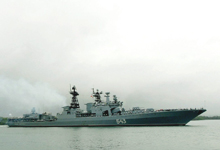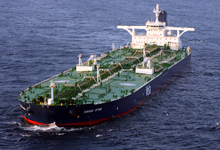 |
| The Russian warship 'Marshal Shaposhnikov' which undertook the rescue operations |
When the supertanker 'Moscow University' was seized by Somali pirates off the coast of Yemen in May of this year, the attack could well have ended up with the vessel, its 80,000 tonne cargo of crude oil and the crew being held for ransom for an indeterminate length of time.
In the event the pirates were thwarted by the twin facts that this was a vessel well prepared for the eventuality of an attack and in relatively close proximity to the Russian warship 'Marshal Shaposhnikov'.
As the pirate attack threatened to overwhelm the 23 crew members aboard 'Moscow University' they quickly disabled the vessel and locked themselves in a safe room to await rescue.
A helicopter was rapidly despatched from the 'Marshal Shaposhnikov' to conduct aerial reconnaissance. What followed was a dramatic rescue operation in which ten pirates were arrested after a frenetic gun battle on the high seas.
The release of 'Moscow University' and its crew represented an all too brief high in the near constant battle to protect commercial shipping in an area of the world blighted by almost continual acts of piracy.
Russian, European Union (EU) and American naval forces have been deployed to the region in the hope of preventing or deterring attacks. Nevertheless, the pirates are reported to be currently holding more than 20 foreign ships and a crew of almost 400.
Acts of piracy surge
Pirates are reported to be currently holding more than 20 foreign ships and a crew of almost 400 |
The EU has acknowledged that the pirate threat in the Horn of Africa region is "an expanding phenomenon", both in terms of level of activity and range.
Rear Admiral Peter Hudson, Operation Commander EU Naval Force (Navfor), enumerated the continuing threat of piracy in the region, when he recently stated that a huge surge in Somali pirate attacks meant that activity in March was double that of the three months from September to November last year. Hudson says that the priority for international navies is now to increase co-operation and concentrate forces to counter this new swarming tactic on the part of the pirates.
EU Navfor previously focused its activity within the so called Internationally Recommended Transit Corridor (IRTC). This has helped reduce attacks against commercial shipping using the IRTC to a trickle (only three have been reported in the past 12 months), but it has also served to drive the problem into the much less controllable vast swathes of the Indian Ocean, where EU Navfor's reach is limited by time and distance.
EU Navfor prefers to view the shift in pirate activity as evidence of its success in protecting commercial shipping. Just five short years ago the attack range was just 287km (165 nautical miles) from the Somalia coast line though. Recently, a ship was hijacked 2,037km (1,100 nautical miles) from the Somali coast - and only 926km (500 miles) from the coast of India.
A cynic might argue that such claims on the part of EU Navfor amount to nothing more than a political smoke and mirrors game, given that the reach of pirate activity has expanded exponentially and shown no sign of abating whatsoever.
With only 20 or so warships covering an area of pirate activity ten times larger than that of Germany and which sees some 30,000 commercial vessels pass through it each year, it is not difficult to understand why the pirates often act with impunity.
Dual purpose deployment of EU Navfor forces in particular (some warships are tasked with protecting World Food Programme (WFP) aid convoys inbound to Somalia) serves to compound the resource issue and potentially limit the scope and reach of protection for commercial shipping.
 |
| 'Sirius Star' whose owners paid some £2.025m for its release |
Self help
Given the immense range that Somali pirates continue to operate within (Red Sea area bordered by Ethiopia, Saudi Arabia and Yemen, Gulf of Aden bordered by Ethiopia and Yemen and the much wider Indian Ocean area bordered by Yemen and Oman to the North, Seychelles and India to the East and a chunk of the Kenya coastline stretching well beyond territorial limits to the South) it's pretty evident that vessels operating in this area cannot expect immediate military assistance.
Self preservation is paramount and the onus is largely on commercial operators to deliver measures to adequately protect the vessel, its cargo and crew therefore.
The North Atlantic Treaty Organization (NATO) Shipping Centre (NSC) is offering commercial world delegates attending the forthcoming Transportation Security Expo & Conference 2010, an opportunity to take part in a unique tactical floor exercise which will follow a vessels' voyage from departure in Rotterdam to a attack point in the Gulf of Aden, through its capture and on to its eventual release.
This highly specialized full-day exercise is intended to inform and educate fleet owners of what can be expected in the event that a vessel is seized and also offers real world advice on how to harden vessels against an attack.
'Moscow University' crew were extremely lucky in being aboard a well prepared vessel, having a well practised drill in place and being physically close to military assets able to respond in timely fashion. The crews currently held by Somali pirates have not been nearly so fortunate.
The International Maritime Organization (IMO) conference being held at the same event will complement the tactical floor exercise with a clear focus on an examination of both current and future international policy and regulations in respect to maritime security and how this impinges on the shipping industry.
Swarm tactics
EU Navfor's Adm Hudson recently told the BBC "that what we have seen in the southern part of the Indian Ocean, the Somali basin, is almost swarm tactics by some of the pirates who try to flood the area with action groups."
He insisted that the international naval forces are able to make a difference and navies believe they are reducing the number of successful attacks though.
"By correctly positioning our aircraft, putting our ships in the right area, we have managed to break up, dismantle, disrupt over 20 of those groups," he said.
While the number of suspected pirates in jail and facing prosecution in Kenya and the Seychelles has risen significantly, attacks on commercial shipping have continued to be relentless and therefore question the validity of such claims of success.
'Moscow University' cargo of crude oil (valued conservatively at $50m (£33m) and destined for China), delivered a powerful enough incentive for pirates emanating from one of the poorest countries in the world to go and get.
Rich pickings
 |
| Transport Security Expo 2010 offers solutions for the merchant marine operating in treacherous waters |
Somali salaries, assuming work is available, amount to $500 (£340) annually. Those prepared to risk life and limb in a pirate attack can expect a payout of around $29,000 (£20,000) from a ransom when it is paid.
It is reported that the owners of the supertanker 'Sirius Star' paid some $3m (£2.025m) to have the vessel, its cargo of 277,000 tonnes of crude oil and its 25 man crew released in 2008/2009.
In 2009, the owners of the Danish owned and operated 'CEC Future' paid out an estimated $1m (£610,000) to $2m (£1.22m) but refuse to admit the precise figure.
As recently as June of this year the pirates released the British flagged vehicle carrier 'Asian Glory' and it's predominantly East European crew (held since January). The 45,000-tonne ship was hijacked 1,000km (620m) off the Somali coast. It is not yet known, though suspected, whether a ransom demand was paid.
Ample evidence now exists to show that those who finance the pirate attacks have very rich pickings but such attacks also fuel local economies as well. Local commodity suppliers often provide essentials, including food, on credit to keep those held hostage alive. Financiers and suppliers often exact their pound of flesh when a ransom demand is paid.
Lessons learned
With military resources spread across the region and payment of ransoms only serving to exacerbate the piracy issue, the onus rests firmly on the shoulders of the commercial sector to better protect vessels, cargo and crew members from the eventuality of an attack.
NAT0's tactical floor exercise, when combined with the IMO's policy and regulation conference programme, delivered under the auspices of the forthcoming Transportation Security Expo, deliver a unique opportunity to gain best practice knowledge and expertise for the merchant marine operating in treacherous waters.


















